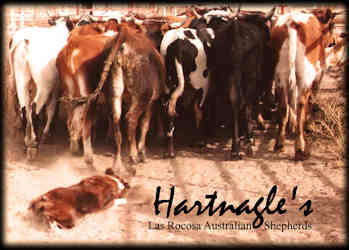|
1500s
- First sheep and Spanish Shepherd dogs introduced to
the American west
- Don Juan de Onate, a Basque drove 2,900 sheep into
the Chama River country
|
|
1800s
- “Little blue” dogs were identified in the American
West with Basques and bands of sheep
- Basque sheepherders were working in Cahuenga Valley
long before it became known as Hollywood
- The Basque people dominated the sheep industry from
1873 to 1973, a period of 100 years
- German Koolies (Coolies), very similar to Australian
Shepherds reported in Australia
- Australian Shepherds imported to Western U. S. with
flocks of sheep
- Kennon Goodrich, Dr. Heard’s great-grandfather leaves
Texas headed to Oregon in a wagon train with two blue
merle bob-tailed shepherds, Carlo and Towser
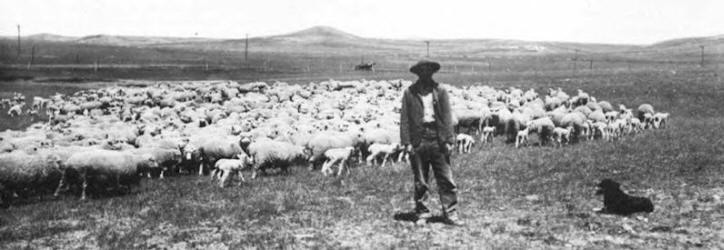
|
|
1915
- Harold Mitchell (married to Ongiva Gibson) trailed
sheep between Omaha Stock Yards and the San Luis Valley
in Southern Colorado using blue bobtails
|
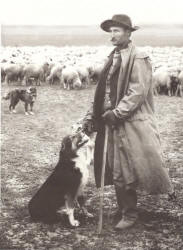
Early 1900s
|
|
1917
- Elsie Cotton’s uncle, Earl Babcock acquires 2 males
and 3 females from Colorado or Montana
- Breed referred to as Australian Shepherds (Maryland
Little, early California breeder and historian contends
the name, Australian Shepherd may have become popular
due to breaking away from Spanish domination and the
resulting animosity towards them) |
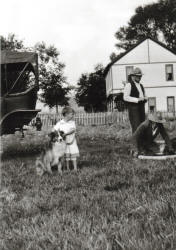
1915 - 1918
|
|
1920s
- Juanita Ely - is gifted Teddy, a little blue dog from
Andorra (between Spain and France) that arrived in the
United States with a boatload of sheep from Australia
- Neville “William” Gibson (Elaine Hartnagle’s father)
acquires Bob from Basques
- Noel Heard (Weldon T. Heard’s father) buys Old Jim
- Roy Ritter uses Basque dogs to drive his stock out of
Nevada into Northern California
|
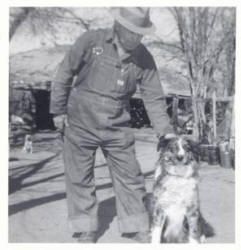
William Gibson & Bob
|
|
1922
- Russell Peer (Vicki Mistretta’s father) with a pup
named Jimmy and a pig named Nancy. He worked for his
father who owned three large ranches, two in Oregon and
one in northern California where he ran thousands of
sheep before the Great Depression
|
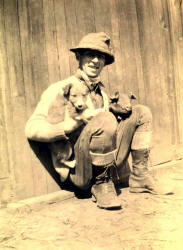
Russell Peer 1922
|
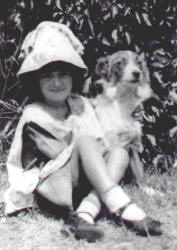
Elsie with her
Uncles female "Cotton"
|
|
|
1924
- Bunk an Australian Shepherd from Australia
is featured in several films between 1924 and 1932 with
Silent Film star and owner, Jack Hoxie
- Earl Babcock, Elsie Cotton’s uncle acquired 2 males -
one (maybe both) had been imported from Australia
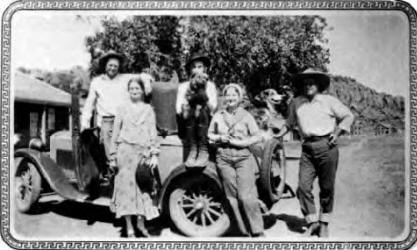
Jack Hoxie & friends - 1930
|
|
1926
- Breed Standard drafted for Pyrenean Shepherds (Berger
de Pyrenees). All varieties are combined into two
recognized types
|
|
1930
- ASCA’s first President, Eloise Hart’s family acquires
Blanco from a migrating family who came to California
directly from the Basque country in Spain
|
|
1932
- Thayer’s Padrick King - 1932-1949 is born who will
receive the Red Heart Badge of Heroism at sixteen (16)
years of age for saving his mistress, Marie Thayer’s
life in Lolo Montana
|
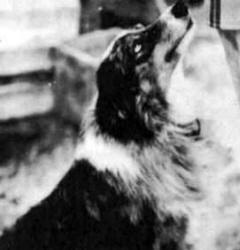
Thayers Padrick King
|
|
1937
- Ina Ottinger’s parents of Casper Wyoming started
breeding their line of ranch dogs when they imported two
dogs from Spain
|
|
1938
- Cub and Harry Sandburg, Colorado ranchers use early
versions of Australian Shepherds to work cattle near
Montrose, Paradox and Cedaredge Colorado
- Jon Eckert (a Florida Aussie fancier and Sandburg’s
grandson) introduced to Shepherds as a child in Colorado
|
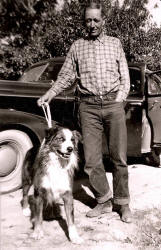
Harry Sanburg & Bob
|
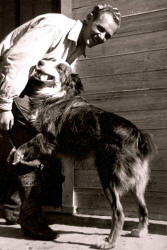
Cub Sanburg & Bob
|
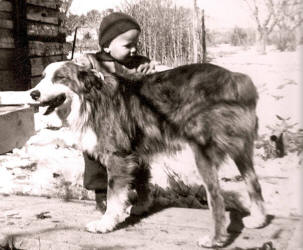
Jon Eckert & Bob
|
|
|
1939
- Don Breazeale uses Aussies on dairy farm in Modesto
California
- Brezeale acquires dogs from Juanita Ely
- Jay Sisler gets his first blue dog
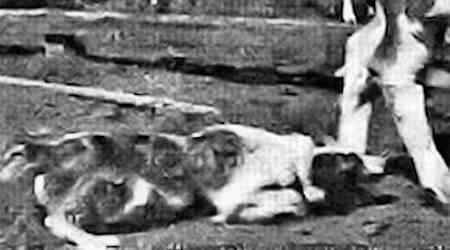
|
|
1940
- Allie Clough acquires dogs from Parker Ranch in
Hawaii early 40s
- Hundreds of Basques were recruited to western sheep
ranches due to the severe labor shortage of the 40s and
50s. They were commonly brought in from Spain with their
dogs to the western states including Nevada where the
sheep industry was followed by cattle ranching
|
|
1942
- 56 million sheep grazed on open range throughout the
west
- “Little blue dogs” start gaining recognition when
they started showing up in significant numbers as
sheepherders brought them as tools of their trade
- The little blue dogs were strongly associated with
the sheep industry in Arizona, California, Idaho, and
Pacific Northwest and then was advanced as a breed in
Colorado with the development of major foundation
bloodlines in the 1950s and 1960s
- California and Idaho are two states with the biggest
Basque population
- The largest community of Basques in North America
exists in the greater Boise, Idaho area
- Between 1880 and 1930, Los Angeles had a flourishing
Basque colony. During those years in the area around
Alameda Street and Aliso Street was the home for one of
the oldest and largest Basque communities in America
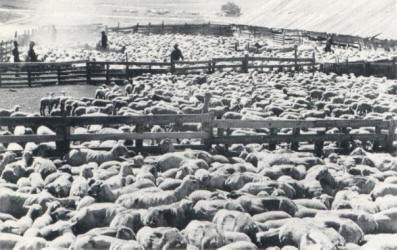
|
|
1944
- Jay Sisler acquires Keeno
- By end of WWII, sheep number less than 40 million
- Breed recognition increases with popularity in
Western riding
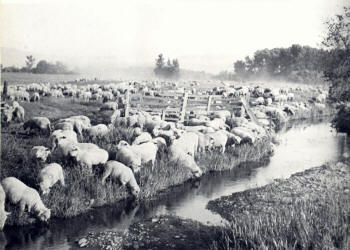
|
|
1945
- Maryland Little develops Mr. Robert’s line out of
Basque and Spanish dogs in California
|
|
1947
- Gene Sisler buys Blue Star
|
|
1948
- Vicki Mistretta receives Tubby, a long-tailed black
tri for Christmas
- Keeno and Blue Star produce Stub and Shorty |

Peers Tubby
|
|
1949
- Jay Sisler’s first public performance. (Photo from
later show)
- Fletcher Wood buys Jay
|
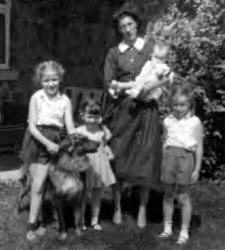
Woods Jay |
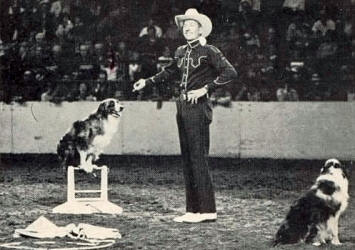
Jay Sisler |
|
|
1950
- Basque sheepherders are imported into the US through
government program to ease labor shortage at the end of
WWII
- Bob and Jean Carrillo, Casa de Carrillo, acquired
their first Aussie, Cookie (from Don Breazeale’s
breeding in Modesto, California)
|
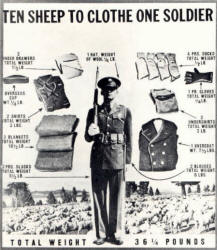 |
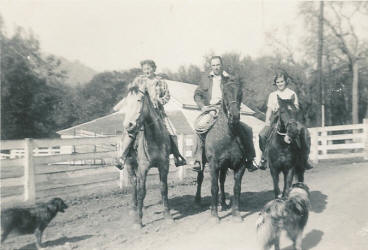
The Carrillo Family
|
|
|
1953
- Ernie and Elaine Hartnagle acquire Snipper from the
Bar Cane Ranches
|
|
1954
- Juanita Ely acquires Feo from a herder working for
the Warren Livestock Company who brought him from the
Spain
|
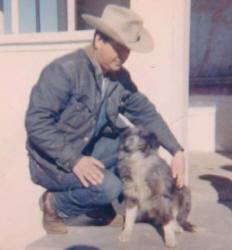
Ely's Feo
|
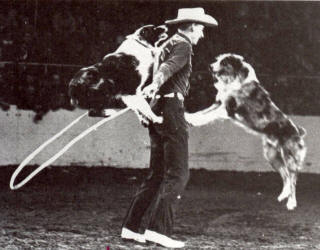
Jay Sisler - Circa 1954
|
|
|
1955
- Hartnagle’s purchase Goody who is a daughter of Ely’s
Feo and Ely’s Blue and Badger, a son of Blue
|
|
1956
- Disney releases "Cowdog" with Jay Sisler, a live
action short film by Walt Disney Productions; Buena
Vista nominated for an Academy Award
- Steve Mansker acquires Freckles from Jay Sisler
- The Drumheller Ranch in Washington employs Gregorio
Zorrozua, a Basque who contracts exclusively Basque
sheepherders from Spain
- Lois George acquires Cricket from Basques
- Audrey and Muriel Hays acquire Poco Lena
|
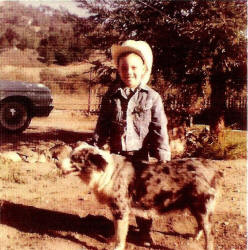
Georges Cricket (1956)
|
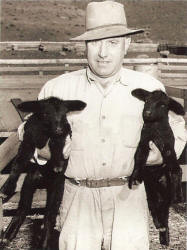
Gregorio Zorrozua
|
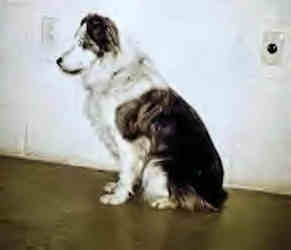
Klarers Poco Lena
|
|
|
1957
- The Australian Shepherd Club of America (ASCA) is
founded to recognize Australian Shepherds (or Sheepdogs
as it appeared on early registration certificates) as a
true and distinct breed
- National Stock Dog Registry, a division IESR becomes
the official registry
- Hart’s Panda (female) first Aussie registered with
NSDR through agreement with Ed Emmanuel
|
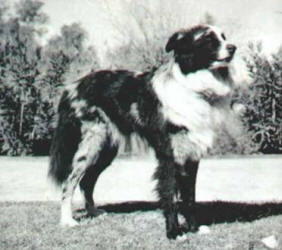
Hart's Panda
|
|
1958
- First ASCA Show - April in Himmel Park in Tucson
Arizona with Judge Eloise Hart
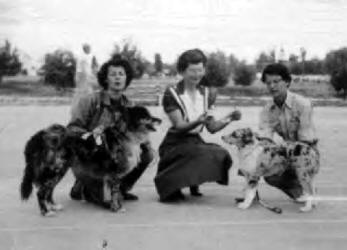
1958 Himmel Park ASCA's 1st Show
|
|
1959
- Fletcher Wood acquires Dandy from Moreno family who
brought dogs to the United States from Spain
- Jay Sisler acquired Panda (by Wood's Jay and out of
Ely's Blue)
- Juanita Ely acquires Spike, a harsh coated dog from
Gene Sisler who originally came from the Pyrenees with a
Basque sheepherder
- Ken Duart acquired Duart’s Lita from a Basque
sheepherder at Nelson’s ranch in Bakersfield who brought
her from the Basque sector on the French and Spanish
border
|
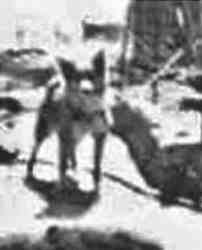
Woods Dandy
|
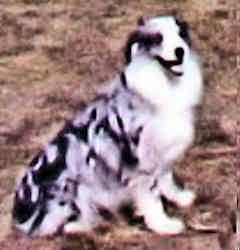
Sisler's Panda
|
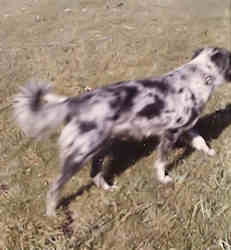
Duarts Lita
|
|
|
1960
- Harper’s Old Smokey - Janeane Harper, Kansas
- Stevenson’s Kate with litter - Gwen Stevenson,
Northern California
- DeGreen’s Smokey - Lucie DeGreen, Arizona
- Lee Thornton establishes foundation bloodline in
Arizona
- Spencer’s Jerry - Harold and Pauline Spencer, 5S
Ranch - California
|
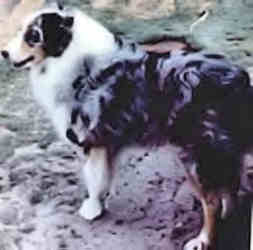
Harpers Old Smokey
|
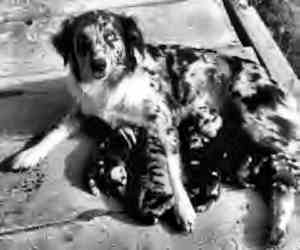
Stevenson’s Kate with litter
|
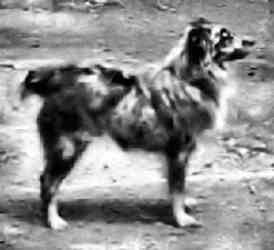
DeGreens Smokey
|
|

Spencer's 5 S Ranch
|
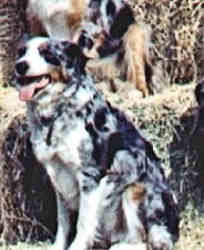
Spencers Jerry
|
|
|
1962
- ASCA Incorporates in Washington State
- August 1962, the ASCA BOD selects a sketch of Ely’s
Blue to be representative of the breed as the Ghost Dog
on the Gold IESR Registration Certificates
- Ina Ottinger purchased a little red merle from a
Basque sheep shearer during the World’s Fair in Seattle
Washington who brought him from Spain
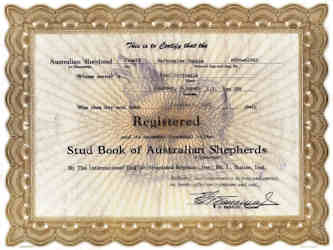
IESR Gold Certificate
|
|
1963
- Roy Ritter injured on horseback when his horse fell
down an arroyo - pinning him beneath the animal - while
working stock on his ranch outside Reno Nevada, Ritter’s
Streak traveled for miles to get help for his master
- Stanley and Laurel Ronsely of Carson City Nevada
continue Ritter’s bloodlines
|
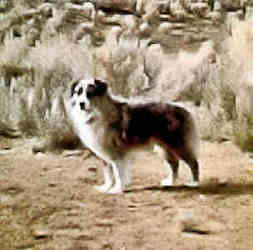
Ritters Streak
|
|
1964
- Dr. Heard establishes Flintridge bloodlines in
Colorado
- Jerry and Sharon Rowe and Dick Sorensen form J Bar D
Kennels in Colorado
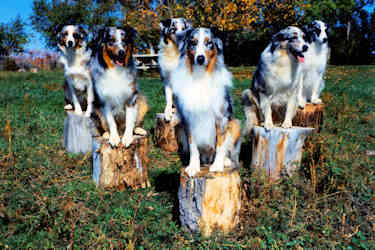
Flintridge established
|
|
1965
- A well-known, foundation sire, McConkey's Tiger
Britches in California tracing back to old Basque and
Spanish ranch dogs |
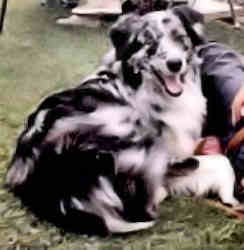
McConkey's Tiger Britches
|
|
1966
- Orthopedic Foundation (OFA) established
- First OFA Certificate (AS-1) issued to Nelson's
Samantha CDX who traced back to Roy Ritter’s Nevada
ranch dogs including Ritter’s Streak
- IASA (International Australian Shepherd Association)
starts registry
|

Betty Nelson
|
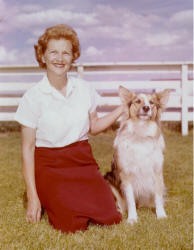
Smedras Blue Mistingo
|
|
|
1967
- Australian Shepherds still being tested by the
uncompromising yardstick of performance
- Sisler’s Silver stars in Disney’s "Run, Appaloosa,
Run"
|
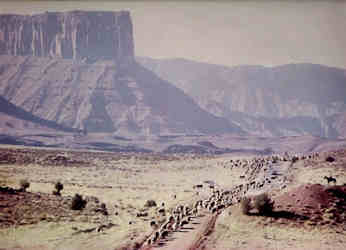
The "yardstick"
|

Sisler's Silver in
Run, Appaloosa, Run
|
|
|
1968
- Rich Ruddish paints Christmas greeting for Hallmark
using Aussie
- Ernie Hartnagle elected President of the ASC of
Colorado
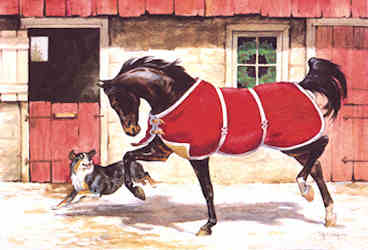
|
|
1969
- ASC of C Logo Designed by Judy Kelley based on Wood’s
Jay’s image
|
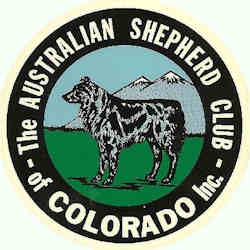
|
|
1970
- ASCA registers first Kennel Names (Las Rocosa and
Maywood) - this is significant for record keeping (to
keep track of Australian Shepherd ancestry)
- Honorable Mention - Las Rocosa Veil of Tears is first
Australian Shepherd to receive IESR Registry Certificate
documenting 3 full registered generations (both sides)
of ancestry
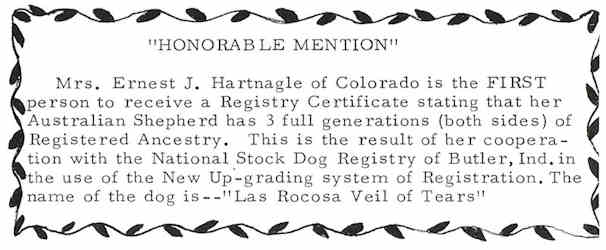
Las Rocosa Veil of Tears & her certificate
|
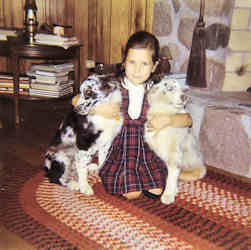 |
|
1971
- ASCA offers conformation, obedience and tracking titles
- ASCA’s first Champion/CDX of record - Champion
Wildhagen’s Dutchman CDX
|
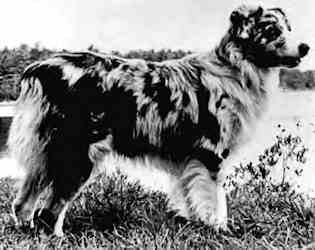
Champion Wildhagen’s Dutchman CDX
|
|
1972
- ASCA establishes Independent Registry March 10
- 26 ASCA kennel names registered in 5 states
- Prior to ASCA’s formation, breed activity was limited
to the western states primarily in Arizona, California,
Colorado, Idaho, Nevada and the Pacific Northwest
|
|
1973
- Disney releases "Stub: Best Cow Dog in the West", an
updated version of Cow Dog
- Decisive meeting to determine ASCA’s future held in
Redding California
- ASCA Stock Dog committee formed
- Colorado Stock Dog Fanciers host first all-breed
trial with ducks sheep and cattle
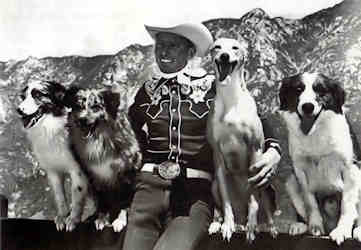
Jay Sisler with John, Joker, Greta & Silver
|
|
1974
- 16.5 million sheep in the United States
- Basque herders no longer recruited from Spain, but
the underpinning for the breed was laid
- Aussies started finding their way into suburbia
- 1,518 Aussies registered in ASCA, 397 litters
registered
- ASCA pilot Stock Dog Trials held in Colorado on May
11, 1974
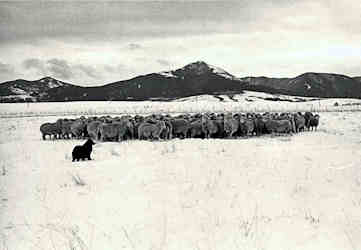
A few of the 16 million sheep in the USA |
|
1975
- ASCA appoints the Colorado affiliate to draft Breed
Standard
- Ernie Hartnagle elected ASCA President
- ASCA Stock Dog Program put into effect
- Australian Shepherds recognized in Mexico
- Australian Shepherds compete at 176 shows in 22
states - resulting in 38 Champions, 35 CD titles, 6 CDX
titles, 3 UD titles earned
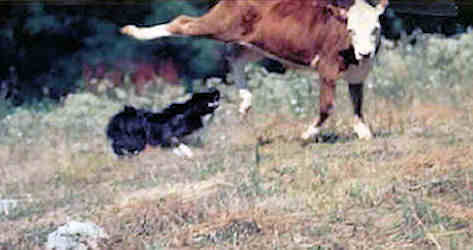
Las Rocosa Cooter
|
|
1976
- Aussies are still the breed of choice on western
ranches
- 3,000 Aussies registered in ASCA
- 29 Championships were earned, 44 CD titles, 8 CDX
titles, 4 UD titles, 1 TD title
- Mab du Hic, a natural bobtail blue merle Pyrenean
Shepherd - living proof of a variety of Pyrenean
Sheepdogs with a smooth face and copper trim (bred by M.
Perrot) existing in the Pyrenees in the 70s and of the
type that were brought to the U.S. through the Western
Range Association
- When Ernie
Hartnagle took office in January, he had the books
audited - and to his surprise discovered there was a
total sum of $15.00 in the treasury
- CERF (Canine Eye
Registration Foundation) introduced

Mab du Hic
|
|
1977
- ASCA's Official Breed Standard Adopted to describe
the physical characteristics of the ideal specimen of
the breed as a judging and breeding guideline
- Champion Copper Canyon Caligari CD selected BOB at
National Specialty
- Junior Showmanship Program initiated
|

Junior Showmanship
|
|
1978
- 6,000 ASCA registered Australian Shepherds
- National Finals – High in Trial / Champion Las Rocosa
Heck’s Hud
- Breeder Judge Program established
|
|
1979
- ASCA and IASA merge their registries under one
umbrella
- ASCA Yearbook, 1957 - 1977 Twenty Years of Progress
published
|
